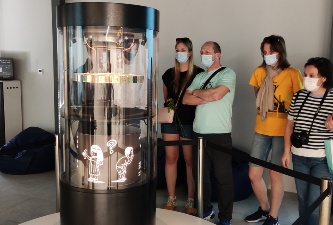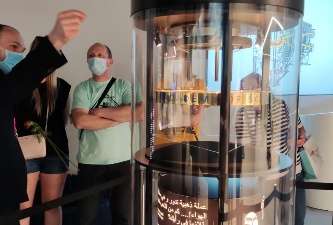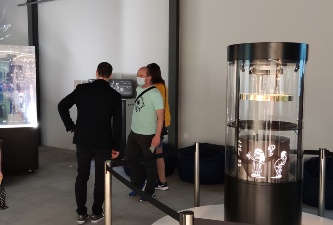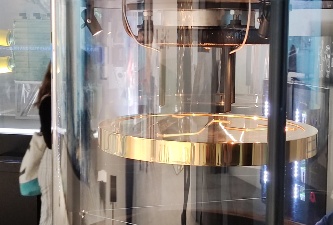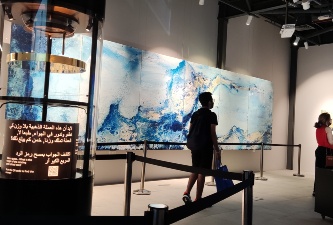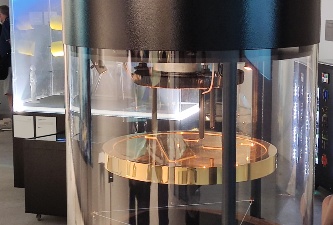Flywheel energy storage
The principle of a flywheel for energy storage has long been known and used. The energy is stored in the flywheel’s rotational motion, which in our exhibit is in the form of a gold-plated coin with the logo of the Czech Academy of Sciences. In order for the rotation of the coin to not be stopped by mechanical friction that occurs in regular friction or ball bearings, the flywheel (coin) is stored on a magnetic bearing. There are magnets both inside the coin and in the case above it. In practice the air is also removed from the space around the flywheel because even friction from the air could slow down the flywheel.
How energy is transformed
Electric energy can be transformed with the help of the built-in electric machine into the energy of the rotating flywheel and vice versa. This principle is used to temporarily accumulate electric energy during periods of excess power in the electric grid and to return the energy to the grid during power shortages.
How levitation is stabilised
A magnetic bearing is naturally unstable, however. We all played with two magnets that mutually repelled each other when we were kids. Keeping one magnet above another is practically impossible. Thus, if this bearing was not stabilised, the flywheel would have the tendency to “pop out”. Since in practice a flywheel can weigh up to several tonnes and rotates at several thousand rpm, this could end tragically. This is why the movement of the flywheel has to be constantly stabilised. Present-day technologies use superconducting magnets for stabilisation, though they require technically complex and energy-demanding cooling to temperatures of around -200 °C. A considerable amount of energy is lost in this manner. The technology developed by the Institute of Thermomechanics of the Czech Academy of Sciences gets rid of this problem. Instead of expensive superconducting materials and complicated cooling with liquid nitrogen, it uses regular permanent magnets, whose magnetic fields are monitored by an array of Hall sensors and controlled electronically. The resulting movement is further stabilised by electrodynamic damping. The result is a stable flywheel that revolves around its axis with a negligible loss of energy.
How the coin was made
A neodymium disc magnet is concealed inside the aluminium coin. The magnet is carefully balanced using adjusting mechanisms and small weights, so that the coin rotates stably. The aluminium coin was first machined on a lathe, then the logo of the Czech Academy of Sciences was engraved using CNC high-speed milling. The resulting surface was ground three times, polished by disc three times and finally all the nooks and folds along the outline of the logo were polished by hand.
This, however, was just the beginning of a long road, which ended with the surface of pure gold. This is because gold cannot be applied directly on aluminium. Several layers of various metals have to be applied and carefully polished before the application of the last and most beautiful layer - gold!
The first layer is zinc and was created by galvanisation. After it was polished the second layer was formed by electroless nickel plating. This was followed by polishing and another layer of nickel, this time created by electrolytic nickel plating. After the necessary polishing the electrolytic copper plating followed. The next step was disc polishing and polishing all the folds by hand. The fifth layer is comprised of electrolytic nickel plating. This is once again followed by disc polishing and polishing by hand.
And now for the best part. After carefully checking the surface of the coin, the sixth and final layer was applied, made up of pure, 24-carat gold. This layer of gold is only 3 thousandths of a millimetre thick and weighs 20 grams! This amount of gold can be bought on the market for 1100 American dollars (4000 dirhams). If you were to roll the gold into a ball, it would have a diameter of 1.2 cm.
After reading these lines, you certainly will not be surprised that the price of the gold comprises only a fraction of the price of the coin.
At the very end, the blue text “Czech Academy of Sciences” was printed on the circumference of the coin.
